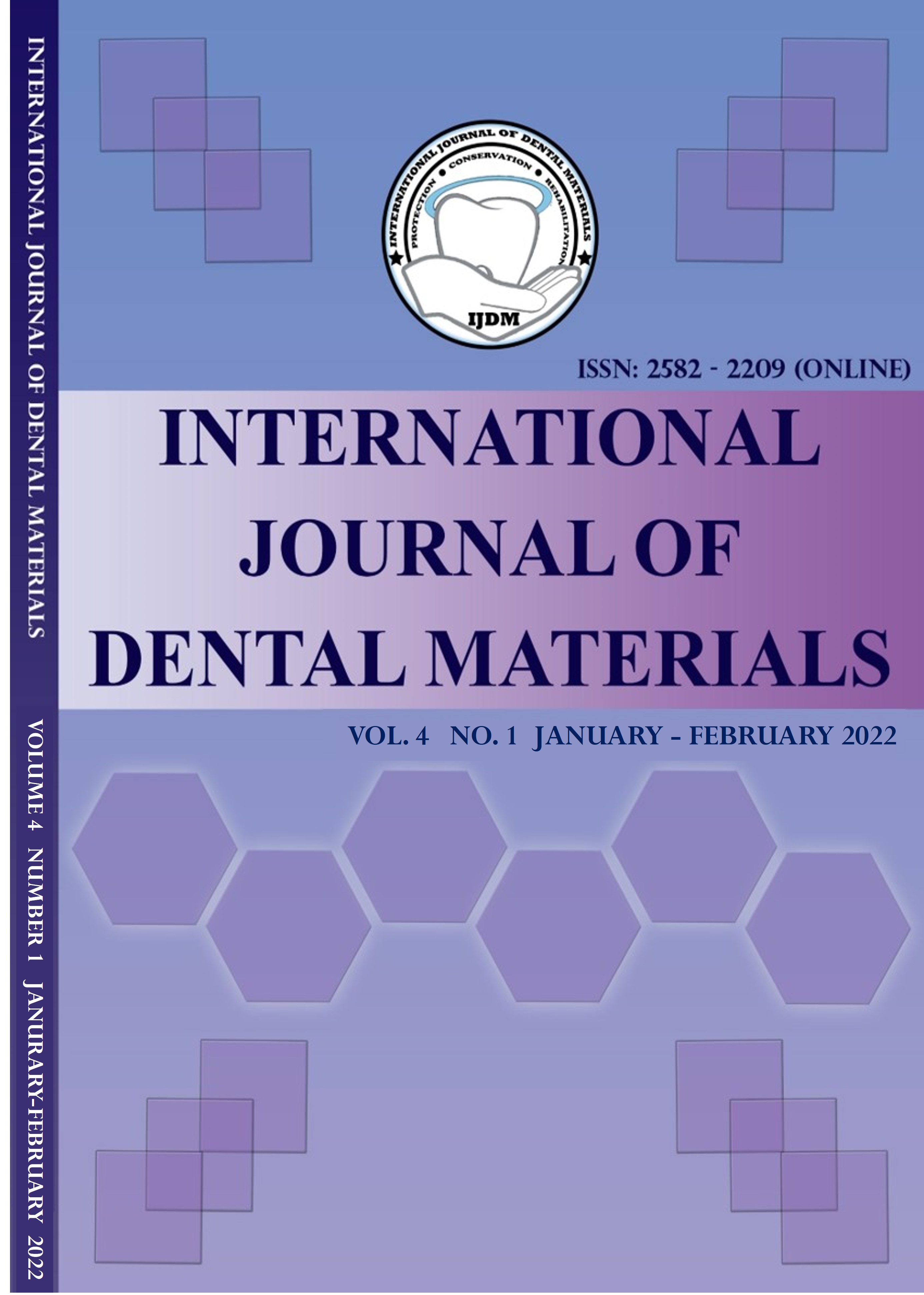Comparative evaluation of remaining dentin thickness with three different rotary Ni-Ti File systems: an in vitro CBCT study
Main Article Content
Abstract
Background: Endodontic therapy and its success depend on effective cleaning and shaping the root canal without deviating from the original anatomy. Ideally, during root canal preparation, the instruments should always confine to and retain the original shape of the canal to maximize the cleaning effectiveness and minimize unnecessary weakening of tooth structure to achieve the optimal result. The remaining dentin thickness in endodontically treated teeth is a significant factor, which is responsible for its longevity.
Aim: This study aimed to evaluate the remaining dentin thickness after instrumentation with ProTaper Next (PTN), TruNatomy (TN), and Neohybrid (NH) file systems using cone-beam computed tomography.
Materials and methods: Thirty extracted single-rooted mandibular premolars were decoronated and divided into three experimental groups with ten in each. Groups I, II, and III were assigned to the file systems ProTaper Next (PTN), TruNatomy (TN), and Neohybrid (NH), respectively. Cone-beam computed tomographic pre-scans were taken, followed by the biomechanical preparation with the respective file systems. Post CBCT scans were taken and compared with pre-scans for remaining dentin thickness. The data obtained were statistically analyzed.
Results: Among the three file systems, TruNatomy rotary files resulted in significantly less dentin removal (p<0.05). The majority of the intergroup comparisons showed significant differences in remaining dentin thickness after biomechanical preparation at 3, 6, and 9mm.
Conclusion: TruNatomy (TN) exhibited the maximum remaining dentin thickness followed by Neohybrid (NH) and comparatively minimum with ProTaper Next (PTN) file systems.
Article Details
Section

This work is licensed under a Creative Commons Attribution 4.0 International License.
This work is licensed under a Creative Commons Attribution 4.0 International License.
How to Cite
References
Jain A, Asrani H, Singhal AC, Bhatia TK, Sharma V, Jaiswal P. Comparative evaluation of canal transportation, centering ability, and remaining dentin thickness between WaveOne and ProTaper rotary by using cone-beam computed tomography: An in vitro study. J Conserv Dent. 2016;19(5):440. https://doi.org/10.4103/0972-0707.190024
Rao MR, Shameem A, Nair R, Ghanta S, Thankachan RP, Issac JK. Comparison of the remaining dentin thickness in the root after hand and four rotary instrumentation techniques: An in vitro study. J Contemp Dent Pract. 2013;14(4):712. https://doi.org/10.5005/jp-journals-10024-1389
Chaudhary NR, Singh DJ, Somani R, Jaidka S. Comparative evaluation of the efficiency of different file systems in terms of remaining dentin thickness using cone-beam computed tomography: An in vitro study. Contemp clin Dent. 2018;9(3):367.
Capar ID, Ertas H, Ok E, Arslan H, Ertas ET. Comparative study of different novel nickel-titanium rotary systems for root canal preparation in severely curved root canals. J Endod. 2014;40(6):852-6. https://doi.org/10.1016/j.joen.2013.10.010
Peters OA, Arias A, Choi A. Mechanical properties of a novel nickel-titanium root canal instrument: stationary and dynamic tests. J Endod. 2020;46(7):994-1001. https://doi.org/10.1016/j.joen.2020.03.016
Kabil E, Kati? M, Ani? I, Bago I. Micro-computed Evaluation of Canal Transportation and Centering Ability of 5 Rotary and Reciprocating Systems with Different Metallurgical Properties and Surface Treatments in Curved Root Canals. J Endod. 2021;47(3):477-84. https://doi.org/10.1016/j.joen.2020.11.003
Orikamhealthcare Neohybrid brochure. Available at https://orikamhealthcare.com/product/neohybrid/. Accessed Dec 15, 2020.
Madani ZS, Haddadi A, Haghanifar S, Bijani A. Cone-beam computed tomography to evaluate apical transportation in root canals prepared by two rotary systems. Iran Endod J. 2014;9(2):109-112.
Suneetha MG, Moiz AA, Sharief H, Yedla K, Baig MM, Al Qomsan MA. Residual root dentin thickness for three different rotary systems: A comparative cone-beam computed tomography in vitro study. J Indian Soc Pedod Prev Dent. 2020;38(1):48-55. https://doi.org/10.4103/JISPPD.JISPPD_190_19
Yadav SS. Comparative evaluation of remaining dentin thickness post instrumentation with three different single rotary file systems–An in vitro CBCT study. International Journal of Medical Science And Diagnosis Research. 2020;4(2): 1-4.
Jain A, Gupta AS, Agrawal R. Comparative analysis of canal-centering ratio, apical transportation, and remaining dentin thickness between single-file systems, i.e., OneShape and WaveOne reciprocation: An in vitro study. J Conserv Dent. 2018;21(6):637. https://doi.org/10.4103/JCD.JCD_101_18
Elnaghy AM, Elsaka SE. Evaluation of root canal transportation, centering ratio and remaining dentin thickness associated with ProTaper Next instruments with and without glide path. J Endod. 2014;40(12):2053-6. https://doi.org/10.1016/j.joen.2014.09.001
Hashem AA, Ghoneim AG, Lutfy RA, Foda MY, Omar GA. Geometric analysis of root canals prepared by four rotary NiTi shaping systems. J Endod. 2012;38(7):996-1000. https://doi.org/10.1016/j.joen.2012.03.018
Ramanathan S, Solete P. Cone-beam Computed Tomography Evaluation of Root Canal Preparation using Various Rotary Instruments: An in vitro Study. J Contemp Dent Pract. 2015;16(11):869-72. https://doi.org/10.5005/jp-journals-10024-1773
Öztürk BA, Ate? AA, Fi?ekçio?lu E. Cone-beam computed tomographic analysis of shaping ability of XP-endo shaper and ProTaper next in large root canals. J Endod. 2020;46(3):437-43. https://doi.org/10.1016/j.joen.2019.11.014
Dhingra A, Ruhal N, Miglani A. Evaluation of single file systems Reciproc, Oneshape, and WaveOne using cone beam computed tomography–an in vitro study. Journal of clinical and diagnostic research: J Clin Diagn Res. 2015;9(4):ZC30. https://doi.org/10.7860/JCDR/2015/12112.5803
Elnaghy AM, Elsaka SE, Mandorah AO. In vitro comparison of cyclic fatigue resistance of TruNatomy in single and double curvature canals compared with different nickel-titanium rotary instruments. BMC Oral Health. 2020 Dec 1;20(1):38. https://doi.org/10.1186/s12903-020-1027-7

